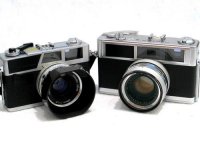I have all five cameras, the GSN is the best performer, and is by far the best value. The GSN has a better lens than the other cameras, and, like the Canonet, it has parallax correction. For a cheap camera, Yashica used wonderful glass and coatings, unfortunately, Canon skimped in this department, and Canon's lenses are very susceptible to fungus, haze, and deterioration of the glass itself. Five of the last six Canonets I have repaired had lenses which were beyond repair, and required replacement of the front and/or rear lens elements.
The only perceived negative of the Yahicas are their battery-dependent shutters, and aperture-priority automatic operation. But so long as you have one with a good POD, and a fresh battery, you will be amazed at the results.
Too bad the Olympus SP is not on the list, it is probably the best fixed lens camera out there, only the Yashica comes close, but the Olympus has the benefit of a mechanical shutter.


